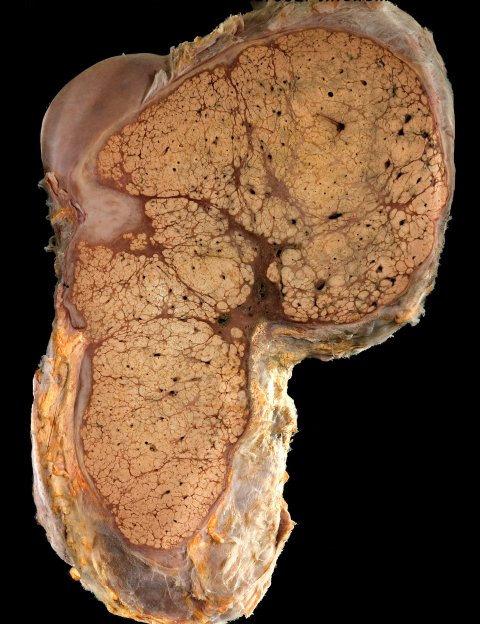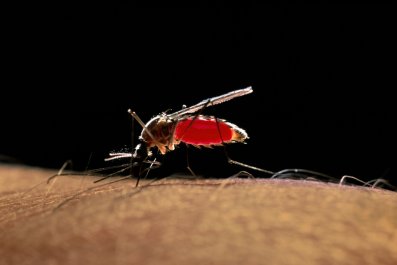Sandra C., a special education teacher in New Jersey, didn't worry too much when her doctor told her to call a liver specialist. Sure, she got fatigued running around with the schoolchildren, and friends sometimes told her she looked green, but in general she felt healthy—she couldn't be that sick.
The phone call she made five years ago shattered her life. "The woman who answered said, 'Abdominal and Liver Transplant Center,'" recalls Sandra, now 52 and retired. "I hung up thinking I must have the wrong number." But Sandra's doctor assured her that she had called the right place—they wanted the specialists there to perform a liver biopsy to investigate why certain enzymes in her blood were so elevated. The invasive surgical procedure showed she was much sicker than she realized. Sandra (who requested to go by her first name only, because she hasn't told some of her family about her illness) had a severe form of nonalcoholic steatohepatitis, or NASH.
As many as 25 million adults in the United States suffer from some form of NASH, and most don't know it. It's underdiagnosed, says Dr. Stephen Harrison, chief of gastroenterology and hepatology at Brooke Army Medical Center, because primary care providers are largely unaware of the disease and because confirming it requires an invasive biopsy. In one study Harrison directed, 400 volunteers who did not know whether they had NASH were brought in; 12 percent ended up with a positive diagnosis, making the disease more prevalent than diabetes. But in NASH, no symptoms typically appear until patients are on the edge of liver failure, fighting for their lives.
According to liver experts, NASH is a silent public health time bomb that may soon overload our health care system with hospital admissions. By 2020, it is expected to eclipse hepatitis C as the leading reason for liver transplants. Doctors say its incidence has exploded in the last two decades thanks in part to the growing prevalence of obesity. While the link between obesity and NASH is still under investigation, the current theory is that excess deposits of fat in the liver lead to damage that can trigger liver failure and death.
Because no treatment or cure exists for NASH, more than a dozen pharmaceutical and biotech companies are in a race to put the first drug on the market. Although large companies like Gilead, Bristol-Myers and Sanofi are involved, the boutique groups Intercept and Genfit lead the pack with Phase III trials scheduled to start this year. The payoff could be massive: Analysts predict that the market for a NASH drug could reach $35 billion or more by 2025.
'Keep On Eating Cheeseburgers'
NASH occurs in four stages. During the first three, fat accumulates in the liver. That accumulation can lead to chronic inflammation and scarring called fibrosis. Over many years, the scarring can progress to cirrhosis, the fourth stage.
Most drug companies are focused on developing a drug to treat NASH in its earlier stages. "The goal is to prevent [patients] from progressing to cirrhosis," says Mark Pruzanski, CEO of Intercept, whose drug, obeticholic acid or OCA, is meant for fibrotic patients. "Once they get cirrhosis…[they] essentially go off a cliff and end up either eligible for a liver transplant or dying." OCA was a success in Phase II trials, reversing fibrosis by at least one stage in a significant proportion of participants. Intercept is now planning a Phase III trial for about 2,000 fibrotic patients. Elafibranor, a drug made by the French pharma company Genfit, is also about to enter Phase III trials, and is also meant for fibrotic patients.
But not everyone is thrilled by the prospect of treating the disease with pharmaceuticals that reverse liver damage. Critics say it would be like putting out a drug that minimizes lung damage in smokers, enabling them to keep lighting up. In the case of a NASH drug, they argue it would be like saying, "Keep on eating cheeseburgers and watching five hours of TV a day."
"It's better to tackle the whole problem of obesity rather than just some effects like NASH," says Dr. Robert Klitzman, director of the master's of bioethics program at Columbia University. "It would be far cheaper to give every doctor's office $50 to have a nurse sit down with each patient and go over diet and exercise, but we have a bias overall as humans and Americans to want a quick fix: 'Just give me a pill.'"
In the context of today's unprecedented prices for some drugs, like the $92,000 annual price tag for Sovaldi's hepatitis C treatment, some worry that a NASH drug would gut the budgets of the public entitlement programs that pay for health care—Medicaid, Medicare and the Veterans Administration. "If these drugs are launched at the same price as Sovaldi, the cost to the public…will be $115 billion per year," projects Llew Keltner, CEO of Epistat, a health care strategy company. "And these will be lifetime drugs, not a single course of therapy like Sovaldi. But none of them will in fact offer anything close to a cure. Weight loss is the only cure for NASH."
Peter Bach, director of Memorial Sloan Kettering's Center for Health Policy and Outcomes, calls such astronomical revenue for the drug companies a "government-enabled wealth transfer, since public agencies take resources from large groups of taxpayers and transfer them to drug company shareholders." If a huge portion of the money in the VA budget goes to paying a pharmaceutical company for NASH drugs, Bach says, "Now we're interfering with that agency's ability to do other things."
Things like eradicating obesity. "If you have a limited amount of resources for health care...then how should we divvy up the money?" asks Klitzman. "Should we put it into very expensive drugs for NASH?" Plus, he points out, while a NASH drug might help the liver, it wouldn't necessarily improve the other costly diseases associated with obesity.

Klitzman blames the free market for incentivizing Big Food and Big Pharma to go for a huge profit at the expense of people's overall health. "There's more money in selling people fatty foods then giving them drugs to treat it," Klitzman says, "than there is in having people live longer, healthier lives through lower-tech solutions: buying everyone a scale and teaching them about watching their weight and exercise."
But losing weight is not easy, as all too many people can attest. Research has found that only a slim minority of people can actually sustain the kind of weight loss that would decrease NASH, unless they undergo bariatric surgery.
But here's where things get even messier—it might not be their fault. Some experts suggest that obesity is a chronic disease with a biological basis. Dr. Jeffrey Friedman, whose studies led to the identification of the leptin hormone, which is vital in the regulation of appetite and body weight, has argued that individuals have a genetic set weight within a 15- to 20-pound range, and if they drop below that, their entire physiology will conspire to bring them back up.
"What's unclear," says his brother, Dr. Scott Friedman, chief of Mount Sinai Hospital's Division of Liver Diseases, "is why in general our mean BMI is going up so precipitously over a short interval because our genes haven't changed." Body mass index, or BMI, is a person's multiplied weight in pounds by 703, divided by height in inches, divided again by height in inches, and it usually correlates with body fat. Someone with a BMI over 30 is considered obese; according to the National Institutes of Health, more than 35.7 percent of adults are obese today, compared with 13.4 percent in the early 1960s. Friedman speculates that this spike may be associated with some evolution of the human microbiome—the bacteria that live in our gut—perhaps in part due to indiscriminate antibiotic use during the past half-century. One recent study found that it's possible to confer a biological propensity for obesity by transplanting the microbiome of an obese mouse into a lean one.
NASH too might have a basis in non-lifestyle factors. Emerging research has found, for instance, that the microbiome of patients with NASH differs from that of healthy people and "may contribute to increased calorie intake." And some skinny people can get NASH. Dr. Julia Wattacheril, assistant professor of medicine at the Center for Liver Disease and Transplantation at Columbia University, says lean people remain underdiagnosed, because they don't meet the classic clinical profile.
The need to develop effective drugs is paramount, says Wattacheril, since at least some of those affected can't blame an unhealthy lifestyle for their predicament. That's why Wattacheril works as the principal investigator on the clinical trials of a drug called GR-MD-02, made by a small biotech company Galectin Therapeutics.
The Mystery IV Infusion
Galectin's CEO, Dr. Peter Traber, was a football player in college—6-foot-4, 240 pounds. Then an ankle injury during a practice forced him to reduce exercising, and he put on 50 pounds. As he entered middle age, enzymes in his blood associated with fatty liver shot up, his glucose increased, and he became prediabetic. Concerns arose that he might have mild NASH, which can be confirmed only by a liver biopsy. In the meanwhile, Traber's doctor prescribed two drugs for diabetes. Instead, he says, "I went home, hugged my children and went on a diet."
Traber, now 60, is down 25 pounds, his liver enzymes have decreased, and his glucose is back to normal. He's the perfect model for the most effective treatment for NASH in its earlier stages: weight loss. Studies have demonstrated that shedding at least 10 percent of one's total weight will reverse most cases of NASH. But once the liver becomes so riddled with scarring that fibrotic tissue replaces the normal tissue, distorting its architecture and redirecting blood flow—as was the case with Sandra—dieting won't save them.
For years, Galectin has been working on a drug for these late-stage NASH patients. The most promising is GR-MD-02, a compound derived from apple peels. Rats were injected with a toxin until they developed cirrhosis, then were treated with GR-MD-02 while also continuing to receive regular toxin injections. In 10 out of 10 treated rats, the cirrhosis scarring reversed dramatically: The percentage of collagen in their livers dropped from 27 percent to 9 percent. "In human terms, that would be like a guy who drinks a fifth of vodka a day, gets alcoholic cirrhosis; we treat him while he's still drinking, and he gets better," Traber says.
After testing GR-MD-02 on monkeys and then in a small group of 30 patients, Galectin is now enrolling patients like Sandra for its Phase II trial. Every two weeks, she travels 95 miles from her home in New Jersey to New York City, where she sits for an hour and a half with a mysterious IV infusion. Neither she nor Wattacheril knows if she's receiving a placebo or Galectin's drug. They won't know until the end of 2017, when the Phase II results will be announced. If the drug works, Traber projects that it could reverse the progression of cirrhosis by 20 years.
Traber and his team say that the last-resort drug they are developing—perhaps in conjunction with a daily pill for earlier stages of NASH that Intercept and Genfit are working on—could ultimately be used for the most critical cases, like Sandra, in which losing weight isn't going to help.
These days, Sandra spends much of her time at medical appointments and physical therapy, since NASH and Type 2 diabetes forced her into early retirement from teaching. If Galectin's clinical trial doesn't work, Wattacheril estimates her odds of dying in the next several years are 40 percent. "I'm in this situation and not for lack of good diet or exercise," says Sandra, whose father died of liver disease 30 years ago. "You can blame me if you like, but I'm doing what I'm supposed to do."
Unlike those who suffer from other serious illnesses, NASH patients have no colored wristband denoting awareness, no annual fundraising race, no built-in support network. Sandra faces an additional burden—she doesn't like to talk about her illness, even to family members, because cirrhosis is more often associated with alcohol abuse, and she fears harsh judgment. "There are a lot of misconceptions," she says, "but any research you can provide for someone who doesn't have a treatment plan or a cure should be investigated. Every life is worth that."




















